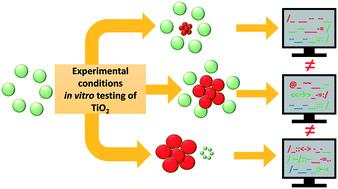当前位置:
X-MOL 学术
›
Environ. Sci.: Nano
›
论文详情
Our official English website, www.x-mol.net, welcomes your
feedback! (Note: you will need to create a separate account there.)
Identifying nanodescriptors to predict the toxicity of nanomaterials: a case study on titanium dioxide
Environmental Science: Nano ( IF 5.8 ) Pub Date : 2021-1-27 , DOI: 10.1039/d0en01031f Sivakumar Murugadoss 1, 2, 3, 4, 5 , Nilakash Das 4, 5, 6 , Lode Godderis 2, 3, 4, 5, 7 , Jan Mast 5, 8, 9, 10 , Peter H. Hoet 1, 2, 3, 4, 5 , Manosij Ghosh 1, 2, 3, 4, 5
Environmental Science: Nano ( IF 5.8 ) Pub Date : 2021-1-27 , DOI: 10.1039/d0en01031f Sivakumar Murugadoss 1, 2, 3, 4, 5 , Nilakash Das 4, 5, 6 , Lode Godderis 2, 3, 4, 5, 7 , Jan Mast 5, 8, 9, 10 , Peter H. Hoet 1, 2, 3, 4, 5 , Manosij Ghosh 1, 2, 3, 4, 5
Affiliation

|
Since the evaluation of nanomaterial (NM) hazards by animal testing is expensive, time-consuming and critical from an ethical point of view, much interest is being given to the development of alternative testing strategies such as computational (predictive) models based on in vitro testing. However, the variations in in vitro experimental conditions can influence the outcome of computational modelling. In this study, we aim to identify nanodescriptor(s) and biological endpoint(s) capable of predicting the toxicity of titanium-di-oxide (TiO2) NMs, and demonstrate how experimental variations determine the outcome of modelling using three case studies. We used TiO2 in vitro data from our previously published study as case study 1 and two other external case studies (case study 2 and 3) performed under different exposure conditions (presence and/or absence of serum). Firstly, we identified the nanodescriptor(s) closely associated to biological endpoints. Secondly, we determined the strength of association of the identified nanodescriptor(s) with the respective biological endpoint. The results indicate that the experimental conditions influence the outcome of the computational modelling. Agglomerate size as a nanodescriptor was well associated with biological endpoints such as DNA damage and/or cytotoxicity. We conclude that, agglomerate size is an important nanodescriptor to assess the toxicological effects of TiO2 NMs in vitro. However, the agglomeration state of NMs can be potentially influenced by in vitro exposure conditions and such influences could be just a confounder in broader contexts such as safety-by-design approaches, which require linking of material specific properties to the toxicological outcome.
中文翻译:

鉴定纳米描述符以预测纳米材料的毒性:以二氧化钛为例
由于从动物的角度评估纳米材料(NM)的危害是昂贵,费时且至关重要的,因此人们对开发替代测试策略(例如基于体外的计算(预测)模型)的兴趣日益浓厚测试。但是,体外实验条件的变化会影响计算建模的结果。在这项研究中,我们旨在确定能够预测二氧化钛(TiO 2)NMs毒性的纳米描述符和生物学终点,并通过三个案例研究证明实验变异如何确定建模的结果。我们在体外使用了TiO 2 来自我们先前发表的研究的数据,分别为案例研究1和其他两个外部案例研究(案例研究2和3),它们是在不同的暴露条件(有血清和/或无血清)下进行的。首先,我们确定了与生物学终点密切相关的纳米描述符。其次,我们确定了已鉴定的纳米描述符与各自生物学终点的缔合强度。结果表明,实验条件影响了计算建模的结果。团聚体大小作为纳米描述符与生物学终点如DNA损伤和/或细胞毒性密切相关。我们得出的结论是,附聚物的大小是评估TiO 2 NMs体外毒理作用的重要纳米描述物。但是,NMs的聚集状态可能会受到体外暴露条件的影响,而这种影响在更广泛的背景下(例如按设计安全的方法)可能是一个混杂因素,这需要将材料的特定特性与毒理学结果联系起来。
更新日期:2021-02-03
中文翻译:

鉴定纳米描述符以预测纳米材料的毒性:以二氧化钛为例
由于从动物的角度评估纳米材料(NM)的危害是昂贵,费时且至关重要的,因此人们对开发替代测试策略(例如基于体外的计算(预测)模型)的兴趣日益浓厚测试。但是,体外实验条件的变化会影响计算建模的结果。在这项研究中,我们旨在确定能够预测二氧化钛(TiO 2)NMs毒性的纳米描述符和生物学终点,并通过三个案例研究证明实验变异如何确定建模的结果。我们在体外使用了TiO 2 来自我们先前发表的研究的数据,分别为案例研究1和其他两个外部案例研究(案例研究2和3),它们是在不同的暴露条件(有血清和/或无血清)下进行的。首先,我们确定了与生物学终点密切相关的纳米描述符。其次,我们确定了已鉴定的纳米描述符与各自生物学终点的缔合强度。结果表明,实验条件影响了计算建模的结果。团聚体大小作为纳米描述符与生物学终点如DNA损伤和/或细胞毒性密切相关。我们得出的结论是,附聚物的大小是评估TiO 2 NMs体外毒理作用的重要纳米描述物。但是,NMs的聚集状态可能会受到体外暴露条件的影响,而这种影响在更广泛的背景下(例如按设计安全的方法)可能是一个混杂因素,这需要将材料的特定特性与毒理学结果联系起来。











































 京公网安备 11010802027423号
京公网安备 11010802027423号